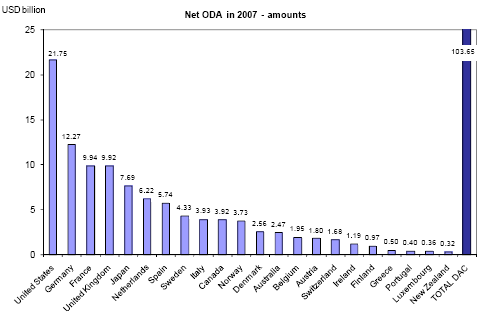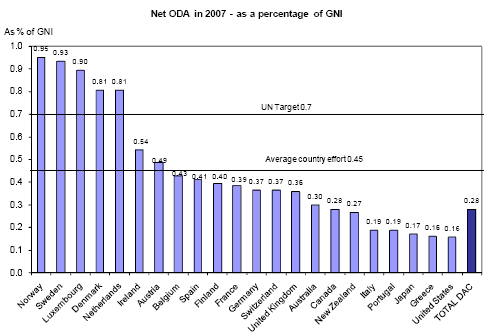Let us have a look at some relevant charts. First, the US is still the largest single donor by overall amount. It is followed by Deutschland:Overall, most donors are not on track to meet their stated commitments to scale up aid and will need to make unprecedented increases to meet the targets they have set for 2010.
With the end of exceptionally high debt relief, total official development assistance (ODA) from members of the Development Assistance Committee (DAC) fell by 8.4% in real terms in 2007 to USD 103.7 billion, according to provisional data reported by members. This represents a drop from 0.31% of members’ combined gross national income in 2006 to 0.28% in 2007.
The fall was expected. ODA had been exceptionally high in 2005 (USD 107.1 billion) and 2006 (USD 104.4 billion), due to large Paris Club [official lending] debt relief operations for Iraq and Nigeria. Debt relief grants diminished in 2007 to USD 8.7 billion as the Paris Club operations tapered off.
Excluding debt relief grants, DAC members’ net ODA rose by 2.4%.
Bilateral aid to sub-Saharan Africa, excluding debt relief, increased by 10% in real terms. This represents an improvement on the recent rate of increase. But it is clear that donors still face a real challenge to meet the Gleneagles G-8 summit projection to double aid to Africa by 2010.

Next, here is the chart of ODA contributions as a percentage of gross national income (GNI uses the same formula for what used to be called GNP: GDP + net factor income from abroad). As usual, the Nordic and Benelux countries set the pace:

Those who are interested or specialize in ODA will no doubt be interested in looking at the other charts posted in a PDF file. Meanwhile, the OECD has this to say about the future prospects for increasing ODA. Apparently, they are not very sanguine:
At the Gleneagles G8 and UN Millennium +5 summits in 2005, donors committed to increase their aid. The pledges made at these summits, combined with other commitments, implied lifting aid from USD 80 billion in 2004 to USD 130 billion in 2010 (at constant 2004 prices). While a few countries have slightly reduced their targets since 2005, the majority of these commitments remain in force...
Overall, most donors are not on track to meet their stated commitments to scale up aid; they will need to make unprecedented increases to meet their 2010 targets. The OECD has completed the first comprehensive survey of donors’ future spending plans to 2010 and the results will be published early in May. While the findings are still to be finalised, the preliminary conclusions that emerge are that donors have programmed around an additional USD 11 billion so far into their planned annual spending by 2010, on top of the extra USD 5 billion for country programmes that they delivered in 2005. This shows that efforts to increase aid are being factored into some donors’ forward plans, but it still leaves about USD 34 billion in 2004 dollars – about USD 38 billion in 2007 dollars – to be programmed into donor budgets if the commitments made in 2005 to substantially increase aid by 2010 are to be fully met.

